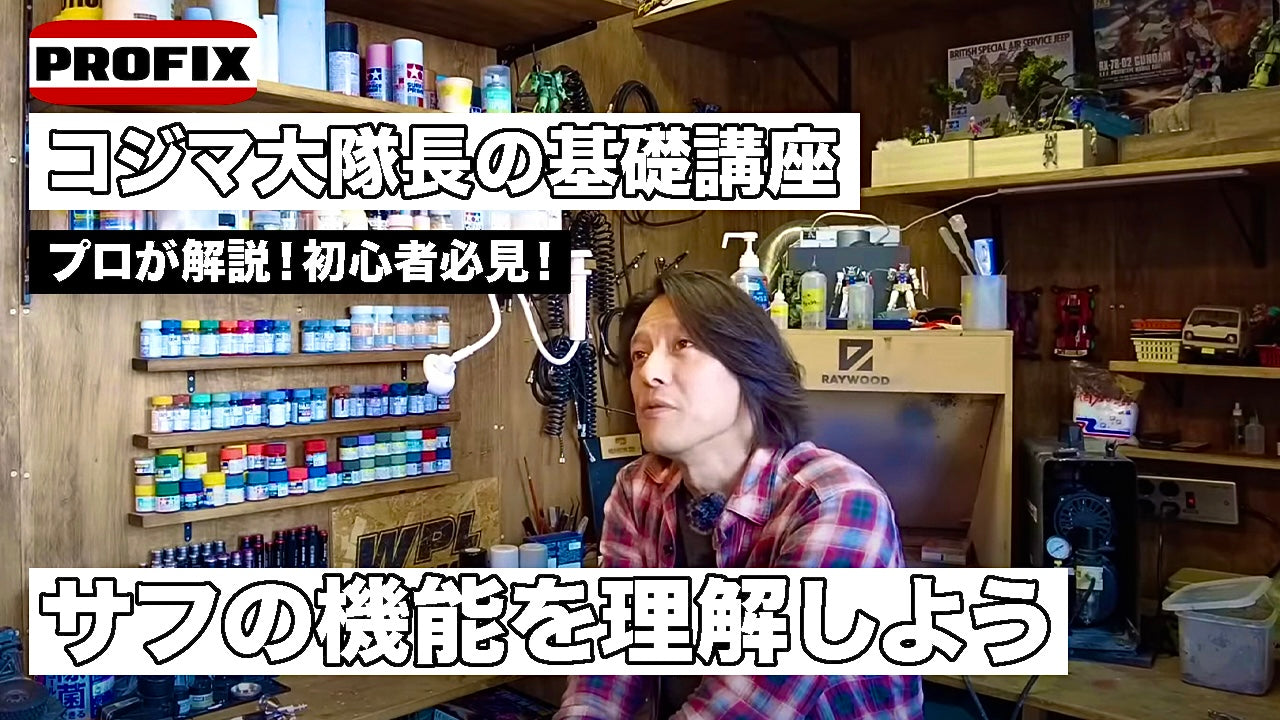[Do you need primer?] - Basic course by Battalion Commander Kojima

Have you ever heard that you need a "primer" (hereafter referred to as "safu") when painting a plastic model?
"You have to spray primer on it."
Or
"The finish will be better if you spray on primer."
Or
But have you ever thought about why you have to blow it?
First of all, what is "surface primer"? Let's think about it again this time.

As a function of a surfacer
Table of Contents [Hide]
①Unify the colors (concealment/light blocking)
Plastic models are, of course, made of plastic resin, so if you shine light on them from behind,
It becomes "transparent". That means that cars and other mechanical objects do not look like they are made of metal. (The definition of metal is that it does not transmit light.)
Therefore, it is necessary to apply a primer coat of paint that does not transmit light before the actual painting, so a primer with excellent light-blocking properties is used.
In addition, for plastic models that have been modified or have had seams removed,
Parts of the kit
Modifications
Additional parts such as plastic plates
Parts filled with putty etc.
In this way, when various different materials are mixed on the surface, it has the effect of preventing the identity of the materials used in the processing from being revealed and creating a unified undercoat state.
② Improve paint adhesion during main painting

Organic solvent-based paints (especially lacquer-based) can form a coating by allowing the solvent (thinner) to penetrate the surface of the plastic resin, but if you spray it repeatedly until the color is completely developed, the surface coating tends to become thicker.
If the paint film becomes too thick, even if you take the time to smooth the surface, the surface tension of the paint will cause the edges to become dull, resulting in an unsharp finish.
It can also lead to filling in the carvings and moldings, resulting in disappointing results.
By spraying a primer beforehand, the solvents in the paint you spray on later will easily penetrate into the base layer, allowing the color to develop and adhere well with minimal spraying.
At this time, it is also important to pay attention to the relationship between the color you spray on top and the color of the primer you choose.
Pink primer/white primer → bright yellow, skin color, red, etc.
Gray Saff/Black Saff → Dark colors such as navy blue and brown

It is best to choose something that goes well with it.
3) To detect scratches that are difficult to see with plastic surgery colors
For example, if the molding color of a part is "white," you can imagine that it would be difficult to find any sandpaper marks or areas where the seams have not been removed properly.
So, once we have finished applying paper using grit ranging from 240 to 400, we spray on a primer to make it more visible, such as a grey color, and then check for scratches.
If necessary, scratches can be filled with super glue or putty and the piece re-sanded, then the entire piece can be sanded down with 400 to 600 grit sandpaper so that there is no difference between the repaired area and the original, and then a second spray of primer (a low-concentration primer will do) can be used to finish the piece.
The first coat of primer is commonly called the "disposable primer."
4. Fill in small scratches
The fundamental difference between a primer and paint is the amount of resin content.
This resin component penetrates into the fine scratches made by sanding, filling them in and creating a smooth surface, but there is an important thing to note here.
Scratches that can be seen with the naked eye are not minor scratches.
Fill the gap properly with putty or something similar, then sand it down until no traces are visible.
The "fine scratches" written on the bottle or can of primer refer to scratches made by sandpaper with 240-400 grit. Even if it looks nice and smooth at first glance, the sandpaper makes the scratches on the polished surface finer and finer, so there are fine scratches on the surface. The real meaning of the primer is that it can fill in these scratches. Please be careful not to misunderstand that primer alone can erase any scratches.

Please understand the above effects of the primer once again.
Should I use it?
Is it okay not to use it?
It is important to judge
There is no rule in this world that says you have to spray a primer! (I can assure you.)
How to enjoy painting quickly without smudges
I don't think it's a good idea to immediately deny the enjoyment of partial painting, which is enough.
⬇️Click here for more details on the article ⬇️
https://www.youtube.com/watch?v=3KP4uC4lOkk
⬇️Items used here ⬇️
PROFIX NITRO-COMP V2 Oil-less Air Compressor
https://raywood.jp/products/nitrocomp-v2
Airbrush Delta Handpiece RH-01
https://raywood.jp/products/r-airbrush-rh01
PROFIX AIR-SYSTEMS Super Drain Filter





